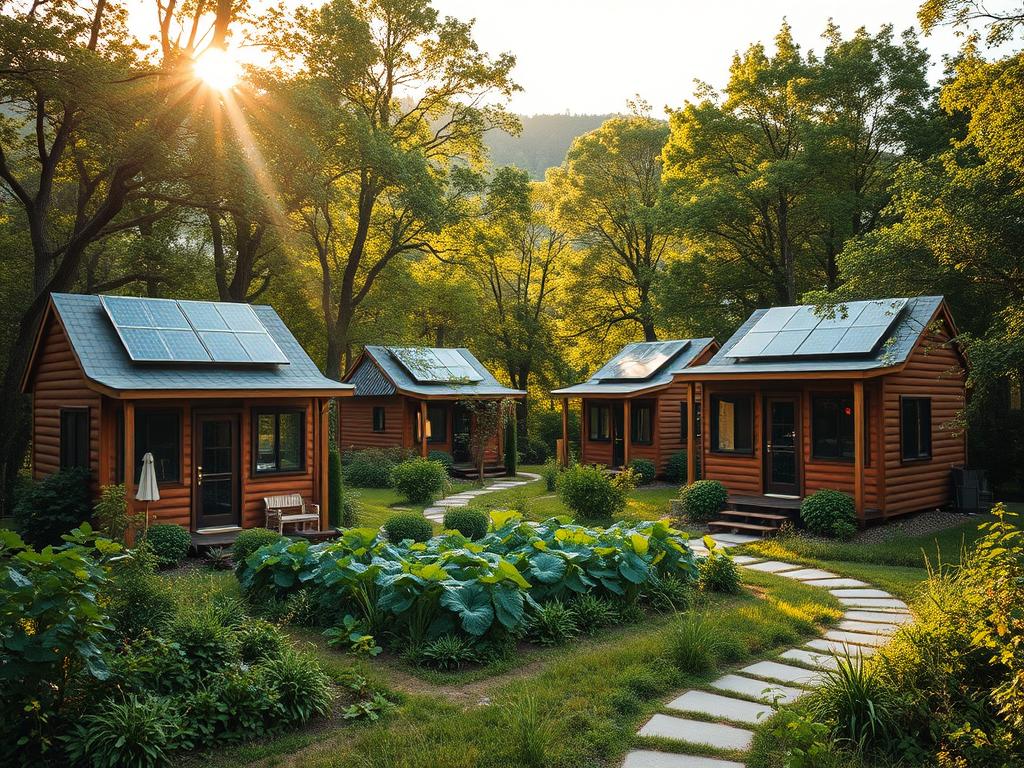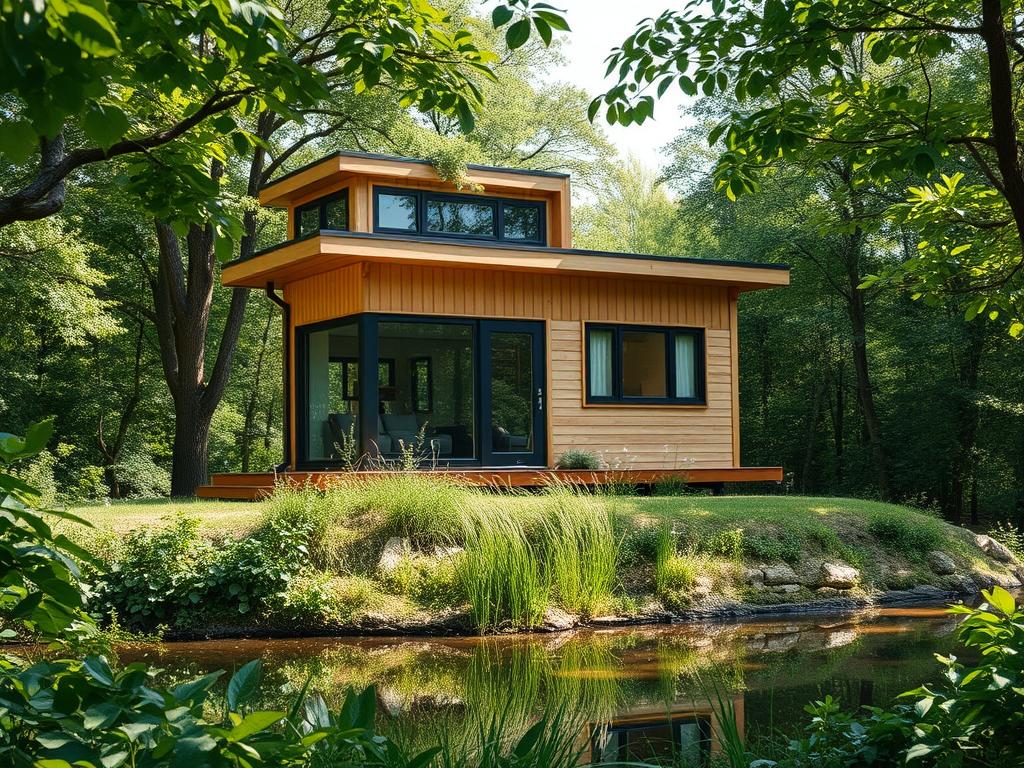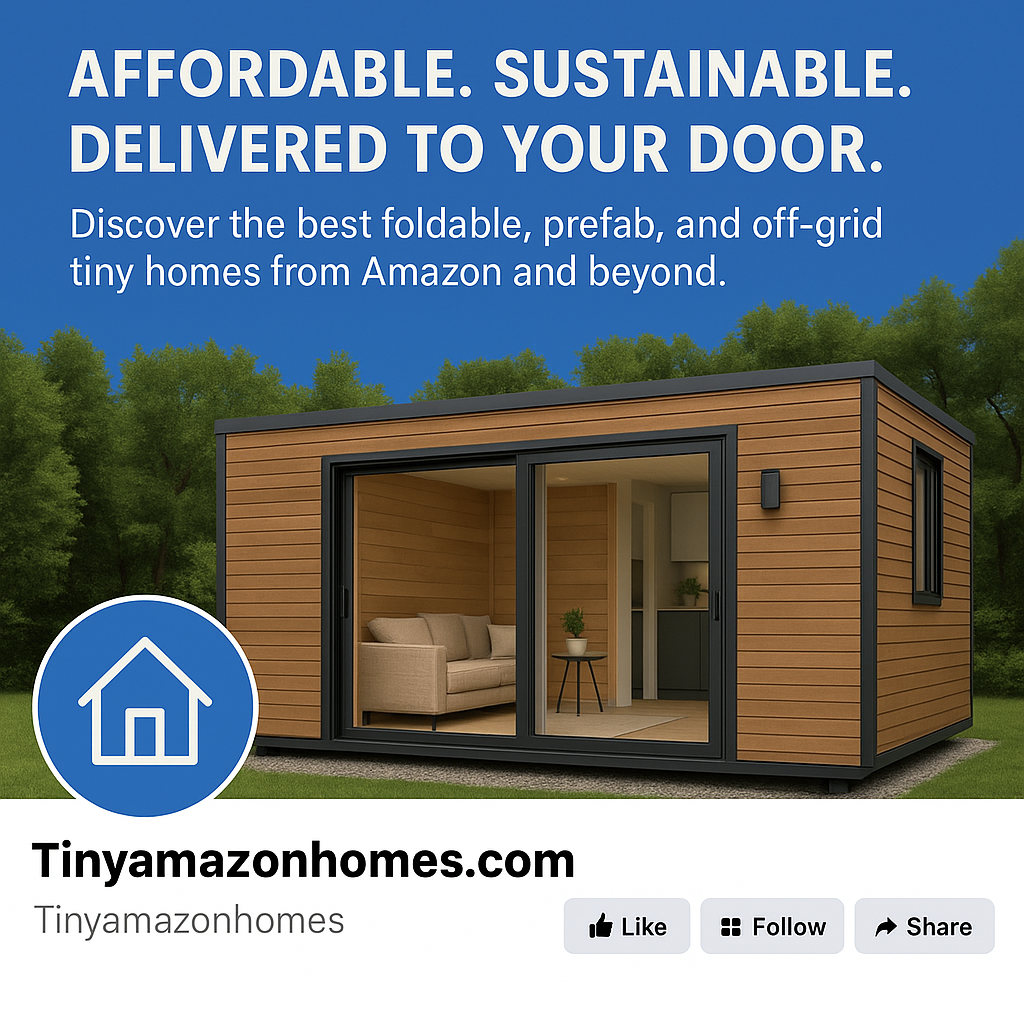The real estate market is tough for those wanting to buy homes. But, a new trend is emerging. Compact living spaces are becoming popular, and big online stores are taking notice.
Did you know many people are choosing customizable, affordable housing options? This change is mainly because of the need for financial freedom and flexibility.
Now, you can find these small homes on a well-known online shopping site. There are many designs and prices to choose from. This makes it a great option for those who want to own a home but don’t want to spend a lot.
Key Takeaways
- Compact living spaces are becoming increasingly popular due to their affordability.
- Online retail platforms are now offering a range of customizable housing options.
- The trend is driven by the desire for financial freedom and flexibility.
- These alternatives to traditional housing come with a variety of designs and price points.
- They offer an attractive solution for those looking to own a home without high costs.
The Rise of Tiny Homes in American Culture
The tiny home trend is growing fast in America. It’s because of many reasons. A Gen Z travel writer says buying a big house is scary. It costs a lot for down payments, closing costs, and upkeep. Tiny homes are cheaper and easier to handle.
The Minimalist Movement and Its Impact
The minimalist movement has helped tiny homes become popular. People want less stuff and less space. This change makes them look for tiny house kits and prefabricated tiny homes that are smart and useful.
Key parts of the minimalist movement are:
- Buying less stuff
- Keeping living areas simple
- Choosing what’s really needed over what’s wanted
Economic Factors Driving the Tiny Home Trend
Money matters a lot for tiny homes too. Housing costs are up, and wages aren’t. Tiny homes are cheaper to buy and use less energy.
The money perks of tiny homes are:
- They cost less to start with
- They use less energy, so bills are lower
- They need little upkeep
Environmental Benefits of Smaller Living Spaces
Living small is good for the planet too. It cuts down on carbon emissions. Tiny homes are built to be green, using eco-friendly stuff and saving energy.
Some green perks of tiny homes are:
- They use less energy
- They use less water
- They make less waste
In short, tiny homes are getting popular for many reasons. The minimalist movement, money savings, and being good for the planet all play a part. As more people want prefabricated tiny homes and tiny house kits, it’s clear this trend is here to stay.
Tiny Homes from Amazon Popularity: Understanding the Phenomenon
The rise of tiny homes on Amazon shows a shift towards minimalism and sustainable living. It’s not just about downsizing. It’s about finding comfort and efficiency in a new way.
Why Amazon Has Become a Tiny Home Marketplace
Amazon’s vast marketplace is perfect for tiny home vendors. It offers online shopping ease, competitive prices, and a wide range of options. This makes Amazon a top choice for those interested in small living spaces and modular tiny houses.
Amazon’s outdoor store has many customizable and expandable tiny houses. They are more affordable than traditional homes. This makes tiny homes more accessible, letting more people try alternative living.
Sales Statistics and Growth Trends
Sales data for tiny homes on Amazon shows a big increase. While exact figures are not shared, reports show sales going up over the years.
| Year | Sales Volume | Growth Rate |
|---|---|---|
| 2020 | $10 million | – |
| 2021 | $15 million | 50% |
| 2022 | $25 million | 66.7% |
Customer Demographics and Motivations
Who’s buying tiny homes on Amazon and why is key to understanding their appeal. Most buyers are between 25 and 45 years old. Men make up a slight majority.
- Primary motivations include:
- Economic factors: Affordability and lower utility costs
- Environmental concerns: Reduced carbon footprint and sustainable living
- Lifestyle choices: Desire for simplicity and mobility
Customers aren’t just looking for a cheaper option. They want a lifestyle change that fits their values and priorities.
Types of Tiny Homes Available on Amazon
Amazon’s tiny home marketplace offers a wide range of structures for compact living. These designs meet various needs, preferences, and budgets.
Prefabricated Tiny Home Kits
Prefabricated tiny home kits are a favorite for those building their own homes. These kits come with pre-cut and pre-drilled lumber. This makes building faster and easier. Amazon has many kits for on-site assembly, offering a budget-friendly option.
Benefits of Prefabricated Kits: They are easy to build, cost-effective, and can be customized.
Shipping Container Conversions
Shipping container conversions are popular for their durability and creative design. These containers are turned into homes, offering a unique look and strong build. For example, a 20-foot container can be transformed into a modern tiny house with steel and wood.
Eco-friendly and sustainable describe shipping container homes. They reuse existing materials.
Modular Tiny Houses
Modular tiny houses are built in a factory and then assembled on-site. This method ensures quality and efficiency. Amazon offers a wide range of modular homes, from simple to complex designs.
- They are built quickly and can be cheaper.
- Modular homes are also more energy-efficient.
Portable Cabins and Structures
Portable cabins and structures are another option on Amazon. They are great for temporary or seasonal use but can also be permanent. These cabins are easy to install and move, perfect for those needing flexibility.
Key Features: They are small, simple to set up, and can be moved.
Amazon’s marketplace offers a wide range of tiny homes. You can find prefabricated kits, shipping container conversions, modular houses, and portable cabins. Each type has its own benefits, fitting different lifestyles and preferences.
Key Features to Consider When Buying a Tiny Home
Exploring tiny homes, especially those on Amazon, requires careful thought. You need to think about comfort, function, and being green. These aspects are key to a happy tiny home life.
Size and Layout Options
The size and layout of a tiny home are very important. You should consider how much space you need for living, sleeping, and storing things. Customizable layouts make tiny homes more livable. Here are some things to keep in mind:
- Available square footage
- Number of floors or levels
- Multi-functional spaces
- Storage solutions
Material Quality and Durability
The materials used in a tiny home affect its durability and quality. High-quality materials help the home last longer and need less fixing. Look at these when choosing materials:
- Type of exterior cladding
- Frame construction material
- Roofing material and quality
- Finishing materials (e.g., flooring, interior walls)
Insulation and Weather Resistance
A well-insulated tiny home keeps you cozy and saves on energy. Look for:
- Type and quality of insulation
- Window quality and energy efficiency
- Door seals and weatherstripping
- Overall building envelope performance
If you want to live off-grid, the home’s ability to stay warm or cool is crucial.
Plumbing and Electrical Considerations
The plumbing and electrical systems are essential in any home, including tiny ones. Think about:
- Water supply and storage solutions
- Plumbing material quality
- Electrical system capacity and safety features
- Renewable energy options (e.g., solar panels)
Good design and installation of these systems make a tiny home better to live in and more eco-friendly.
Top-Rated Tiny Home Models on Amazon
Amazon has a range of tiny home models that are eco-friendly and compact. These homes are sustainable and offer a unique living experience.
Allwood Solvalla Garden House (90 sq. ft.)
The Allwood Solvalla Garden House is a tiny home that’s 90 square feet. It’s perfect for those who love simple living but still want style. It’s great for a small garden or as a guest house.
Key Features: Made from high-quality wood, durable, and easy to assemble.
Lillevilla Allwood Cabin Kit (292 sq. ft.)
The Lillevilla Allwood Cabin Kit has 292 square feet of space. It’s great for those who want more room but don’t need a big house. This cabin kit is expandable and can be customized.
Key Features: Includes a comprehensive kit for easy construction, spacious interior, and versatile design.
Expandable Container House by Weizhengheng
The Expandable Container House by Weizhengheng is modern and has big windows. It offers a sleek living space. It’s perfect for those who want a contemporary look.
Key Features: Expandable design, modern aesthetic, and ample natural lighting.
Off-Grid and Eco-Friendly Options
Amazon now offers a variety of eco-friendly and off-grid tiny homes. These homes aim to reduce environmental harm while offering a unique lifestyle. They are designed for those who want to live sustainably.
Solar-Ready Tiny Homes
Many tiny homes on Amazon come with solar-ready features. This lets homeowners use renewable energy. Solar panels are built into the design, providing clean power.
Some models also have energy-efficient LED lighting. This cuts down on energy use.

Sustainable Materials and Construction
The use of sustainable materials is key in eco-friendly homes. Builders choose materials that are recycled or sustainably sourced. This reduces waste and environmental impact.
Experts say, “The material choice greatly affects a building’s environmental sustainability.”
Water Conservation Features
Water conservation is vital in off-grid tiny homes. Many models have low-flow fixtures and rainwater harvesting systems. These features save water and lower utility bills.
Composting Toilet Systems
Composting toilet systems are gaining popularity in tiny homes. They save water and reduce waste. These systems turn human waste into compost, which can be safely used or disposed of.
One manufacturer says, “Composting toilets are a game-changer for off-grid living. They offer a clean and eco-friendly solution.”
In summary, Amazon’s off-grid and eco-friendly tiny homes are a big step towards sustainable living. They feature solar-ready designs, sustainable materials, water-saving systems, and composting toilets. These homes are a great choice for those wanting to lessen their environmental impact.
Price Range and Value Analysis
Amazon’s tiny homes range from affordable to luxurious, fitting different budgets and tastes. This wide price range lets buyers find homes that match their financial plans.
Budget Options Under $20,000
For those with tight budgets, Amazon has prefabricated tiny homes under $20,000. These are perfect for saving money or starting small. They usually need DIY assembly and have simpler designs.
Mid-Range Tiny Homes ($20,000-$50,000)
The mid-range offers a good mix of price and quality, with homes from $20,000 to $50,000. These homes have better insulation, more room, and quality materials.
Premium Tiny Home Offerings
Premium tiny homes on Amazon are for those who want luxury. They come with high-end finishes, advanced features, and stylish designs. These small living spaces offer comfort and style, with top appliances and materials.
Cost Comparison with Traditional Housing
Comparing tiny homes to traditional houses, tiny homes save a lot of money. They need less material and have lower utility bills because of their size.
In summary, Amazon’s tiny homes come in many prices, offering value at every level. Whether you want something affordable or a luxury home, there’s a perfect match for your budget.
Installation and Setup Process
Setting up your tiny home from Amazon is easy if you know what to do. It involves several steps, from choosing how to install it to connecting utilities.
DIY vs. Professional Installation
First, you must decide if you’ll install it yourself or hire pros. Some modular tiny houses and portable cabins are easy to assemble. They come with pre-cut and pre-drilled parts. But, the complexity of your home and your building skills matter.
Installing it yourself can save money and feel rewarding. Yet, hiring pros ensures it’s done right and fast. This might prevent costly errors later.
Foundation Requirements
Before your tiny home arrives, prepare the site and foundation. The foundation type depends on your home’s design and local laws. You might need a slab, pier-and-beam, or a trailer for mobile homes. A solid, level foundation is key for your home’s stability and life.
Utility Connections
Connecting utilities like electricity, water, and sewage is vital. For off-grid living, think about solar panels, rainwater systems, and composting toilets. Plan these connections well to meet local rules and your needs.
Typical Timeline from Delivery to Move-In
The time from delivery to moving in varies. It depends on the setup’s complexity, your home’s size, and your installation choice. Expect it to take from a few days to weeks. Early planning and site prep can speed things up.
In summary, setting up a tiny home from Amazon needs careful planning and execution. But, with the right prep and knowledge, you can manage it well.
Legal Considerations and Zoning Issues
With the rise of off-grid living and compact eco-friendly homes, knowing the legal rules is key. Tiny homes from Amazon are getting popular, but there are many laws to follow. These laws change a lot depending on where you are.
Common Zoning Challenges
One big issue for tiny home owners is zoning laws. These laws can be strict about what kind of homes you can have. For example, some places might not let tiny homes be permanent homes.
- Minimum square footage requirements
- Restrictions on placement in certain zones
- Requirements for foundation types
Building Codes and Permits
There are also building codes and permits to follow. These codes cover things like electrical work, plumbing, and how well the home is built. Following these rules is important to avoid trouble.
- Electrical and plumbing standards
- Insulation and energy efficiency requirements
- Structural integrity and safety standards
State-by-State Variations in Tiny Home Regulations
The laws for tiny homes differ a lot from state to state. Some places are more open to tiny homes, while others are stricter. For example, Oregon and California have laws that help tiny homes fit in better, but other states might not.
| State | Zoning Laws | Building Codes |
|---|---|---|
| Oregon | Relaxed laws for tiny homes | Standard building codes apply |
| California | Specific laws for accessory dwelling units | Energy efficiency standards are strict |
It’s important to know about these laws if you’re thinking about a tiny home from Amazon. Being informed helps you make smart choices and deal with the rules better.
Who Should Consider an Amazon Tiny Home
Amazon’s tiny homes are gaining popularity. They offer a range of tiny house kits and prefabricated tiny homes. These options cater to different lifestyles and needs.
Ideal Candidates for Tiny Home Living
Not everyone is suited for tiny home living. But, it’s perfect for some. Ideal candidates include:
- Minimalists who value simplicity and efficiency
- First-time homebuyers looking for an affordable entry point into the housing market
- Retirees seeking a compact, low-maintenance living space
- Outdoor enthusiasts who need a cozy retreat
These individuals can enjoy the affordability, sustainability, and flexibility of tiny homes on Amazon.

Lifestyle Adjustments to Consider
Before buying a tiny home on Amazon, consider lifestyle adjustments. Living in a tiny home means:
- Downsizing belongings and adopting a minimalist lifestyle
- Being mindful of energy and water consumption
- Adapting to a smaller living space, which may require creative storage solutions
Understanding these adjustments helps decide if tiny home living is right for you.
Recommendations Based on Different Needs
Amazon offers a variety of tiny homes. From prefabricated tiny homes for quick setup to tiny house kits for DIY enthusiasts. Recommendations include:
| Need | Recommended Tiny Home Type |
|---|---|
| Affordability | Basic tiny house kits |
| Quick Setup | Prefabricated tiny homes |
| Customization | Modular tiny homes with expansion options |
By considering these recommendations, buyers can find a tiny home on Amazon that meets their needs and preferences.
Conclusion: The Future of Amazon Tiny Homes
The trend of tiny homes on Amazon is set to rise. More people want affordable and green homes. This is because of economic and environmental reasons.
Amazon will likely stay a big name in tiny homes. They offer many options for different needs and budgets. Shopping on Amazon makes tiny homes more appealing to many.
The future of tiny homes on Amazon is bright. More people are choosing small spaces over big houses. We’ll see more eco-friendly and creative tiny homes on Amazon as the market grows.
